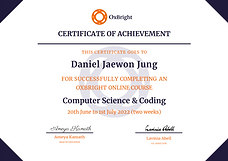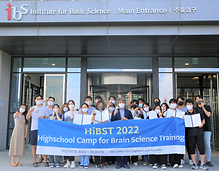Future Biomedical Engineer

I aspire to major in biomedical engineering, a field that merges medicine, neuroscience, biology, and engineering, with the goal of developing innovative digital medical devices and healthcare services. Through various research programs, I have gained experience in areas such as animal dissection, basic neuroscience experiments, programming, device control, and prototyping using 3D printing. More recently, I have engaged in university research focusing on artificial intelligence and histopathology, expanding my knowledge. I have also contributed to biomimetic research, presenting at international conferences and co-filing a patent.

I believe that just as futuristic technologies like autonomous vehicles are becoming part of our everyday lives, medical devices will also experience revolutionary advancements. The integration of IT devices like smartphones and VR with artificial intelligence could lead to the creation of new healthcare tools and more accessible, high-quality medical services. At university, I seek to deepen my understanding of biomedical engineering and explore opportunities to develop cutting-edge medical devices. Ultimately, I hope to use these advanced technologies to make a meaningful impact on both the general public and underserved communities lacking adequate healthcare infrastructure.
RESEARCH EXPERIENCE

Research Intern, Soongsil University (2022-2024)
: Skin Manufacturing and Facial Wrinkle Evaluation System using Muscle Bands

In the field of biomedical and tissue engineering, the integration of contractile skeletal muscle cells with biomaterials is actively being studied for applications such as bio-robots and organ-on-chip systems. A key factor in optimizing these systems is the precise alignment of myotubes, which directly impacts their contraction efficiency and force generation. As a Research Intern at Soongsil University, I participated in a study aimed at enhancing the 3D structural alignment of skeletal muscle myotubes using functional iron oxide nanoparticles (fIONPs). By applying a magnetic field, we successfully achieved controlled alignment of the myotubes, and I presented our findings as the first author at the 3rd World Symposium on Materials Sciences and Engineering 2024 HYBRID. This novel approach to myotube alignment using magnetic fields holds significant potential for advancements in tissue engineering, clinical diagnostics, and tissue regeneration.





Project Intern, Incipian LLC, Irvine, CA, United States (2024)
: Development of Arduino-based Health Monitoring Kit

A pulse oximeter is primarily used to measure arterial oxygen saturation (SpO₂) by detecting the proportion of hemoglobin in the blood. While it's highly effective for monitoring oxygen levels and general tissue oxygenation, it is not specifically designed to assess vascular recovery in localized tissues. During an online summer internship with Incipian LLC, I worked on a project that aimed to calculate vascular reactivity using a pulse oximeter. The research involved using an arm cuff to restrict blood flow and analyzing changes in oxygen saturation during the occlusion. We also studied how temperature affects pulse oximeter readings. This experience deepened my understanding of blood flow dynamics and highlighted the critical role of biomedical devices in healthcare.
ACADEMIC ENRICHMENT PROGRAMS

Oxford Summer Program (2022, Summer)
: Computer Science & Coding


During my first summer vacation in high school, I participated in the online summer camp at Oxford Scholastica Academy to broaden my programming skills. I selected the Computer Science & Coding subject, which allowed me to explore essential topics such as Python and Javascript programming, artificial intelligence (AI), and web development with HTML and CSS. The course effectively combined theoretical knowledge with practical assignments, enabling me to grasp programming concepts quickly. Additionally, the discussion sessions provided an opportunity to hear diverse perspectives from my peers on programming and computers.


Institute for Basic Science (IBS) Summer Camp (2023, Summer)
: Highschool Camp for Brain Science Training


In the summer of my 10th grade year, I was selected as one of 10 finalists for the Brain Science Training summer camp, organized by the Institute for Basic Science. This two-week residential program offered an immersive experience in neuroscience, covering theoretical and practical aspects of molecular biology, electrophysiology, optogenetics, and animal behavior. The program included experiments, seminars, lab meetings, and journal clubs, allowing us to engage with the full scope of the research process. My interest in the human brain interface led me to apply, and through this camp, I gained valuable hands-on experience and a deeper understanding of the future of neuroscience and engineering.






MIT International Science and Technology Initiatives (MISTI)
Winter Workshop (2024, Winter)
: Emergency Medical Services


I participated in the Emergency Medical Services (EMS) workshop offered by MIT International Science and Technology Initiatives (MISTI), where I completed training on both the theory and practice of emergency medical care. Held on the KIS campus, the program included hands-on emergency response training, covering essential medical skills such as first aid, CPR, and trauma management. Through this experience, I gained a deeper understanding of the importance of emergency medical services and recognized the need for innovative medical devices in this field.